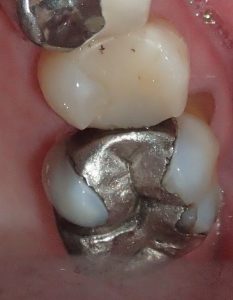Ever wondered what the difference was between silver and white dental fillings? Are amalgam fillings safe? What else is out there? Check out my video to find out!

What’s the Difference?
“Silver” fillings are actually a combination of silver, tin, copper, and typically about 50% liquid mercury. The term “amalgam” refers to the “amalgamation” of these metals to form a solid material!
“White” fillings are also a blend of other materials, hence the term “composites”. In these fillings you’ll find a liquid resin that binds fillers like silica, zirconia, and sometimes acrylics.
The Controversy
A short history of Dental Amalgam
Tin-mercury fillings have been around since 600 AD in China
Western dentists started using it in the 1830s and shortly after, something called the amalgam wars started in America. Apparently there were 3 of these “wars” and I’m hoping to find or write a book on this subject because it sounds amazing.
So from the beginning, there have been pro-amalgam and anti-amalgam dentists that have never managed to agree on whether or not the material should be used.
In recent years, several European countries have banned the use of amalgam fillings in children and pregnant women though it is still widely used in North America.
And the controversy in modern times surrounds the fact that one of the main ingredients, mercury, is toxic and has been linked to several diseases, including:
Brain damage/neurological problems, Alzheimer’s, Multiple Sclerosis (MS), Cancer, Crohn’s disease, etc.
However, the correlation between amalgam and these conditions (so far as I can find) is based solely on self-reported improvements in symptoms when the amalgam restorations were removed. Which means we can’t disprove the connection, but we can’t prove it either.
And what medicine and dentistry try to do is evidence based research to figure out how to best serve our patients.
What we do know is that mercury is released naturally in our environment – in amounts much larger than we’ve been able to measure coming from dental fillings. Most of the research cited by the “anti-amalgam” groups usually cite evidence of diseases caused by environmental mercury.
And the research so far indicates that the only measurable danger of mercury exposure happens when the dental amalgam is placed – hence the use of high-vacuum suctions and ideally the dreaded rubber dam. But even then, it’s considered well within safety limits.
However, what is also clear from the research that it’s hard to measure how much mercury is actually released from dental fillings.
Now if you love your conspiracy theories, here’s something to think about – what reason would the dentists or dental associations have to lie about the safety of dental amalgam? It’s a cheaper material, so dentists aren’t making extra money.
AND if it was linked to all these awful diseases, wouldn’t it make sense for dentists and their assistants to have a higher incidence of these problems? And wouldn’t the associations want to protect themselves from disease?
Why do some dentists still use amalgam?
It’s less expensive, easier to place, lasts a long time, and many dentists still believe it’s a better alternative to composites for children or people with a high risk of getting cavities
Also, there are some downsides to using the white composite fillings: they are not tolerant of water/saliva/blood so more technique-sensitive, more expensive, and some materials have BPA in them (although there are alternatives if you’re looking)
So why don’t I use amalgam?

Not because it’s toxic but because it’s outdated!
Composite resin (white) fillings can conserve more tooth structure because you’re not counting on the shape of
the preparation to hold the filling in place.
We also have composite materials that can release fluoride and other ions to “recharge” the
enamel.
Esthetics also play a big role for many people, even kids.
And I see many more teeth break apart around amalgam fillings than I do composite fillings, although with a big enough filling, any tooth is bound to break no matter the material.
And on the chance that they do one day prove that amalgam fillings are toxic, I will already be ahead of the game.
I hope this post got you thinking. If you have any questions or comments I’d love to hear from you. If you like what you see, please share with your friends and follow me on Google +, Facebook, or Instagram!
And if you’re looking for a dentist in Kamloops, we are happily accepting new patients! You can contact us by clicking here!